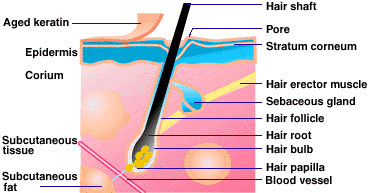Essential Hair Knowledge
We all know what hair is and we all think we know how it grows...here is a great peice with more
than enough information and details for you to become more than enlightened on the subject. My source is:
Fighting Hair Loss written by Dr. Mary Sheen.
Copyrights © 1993-96 USA Library Publishing, Inc.
What is Hair...
Hair is composed of keratin, the same protein that makes up nails and the outer layer of our skin. The part seen rising out of the skin is called hair shaft or strand. Each strand consist of three layers. The outermost protective layer (cuticle) is thin and colorless. The middle layer, or cortex , is the thickest. It provides strength, determines your hair color and whether your hair is straight or curly.
Hair color is determined by melanin from your pigment cells. The more pigment granules there are, and the more tightly packed, the darker the hair. Two kinds of melanin contribute to hair color. Eumelanin colors hair brown to black, and an iron-rich pigment, pheomelanin colors it yellow-blonde to red. Whether hair is mousy, brown, brunette or black depends on the type and amount of melanin and how densely it's distributed within the hair. For example, deep-black hair contains closely packed melanin in the cortex, a few in the cuticle. Very dark hair, quite apart from having more melanin granules than lighter or blonde hair, has more melanin per granule. When pigment-producing cells cease to function, the result is the uncolored white or gray hair.

Below your skin is the hair root which is enclosed by a sack-like structure called the hair follicle. Tiny blood vessels at the base of the follicle provide nourishment. A nearby gland secretes a mixture of fats (called sebum) which keep the hair shiny and waterproof to some extent. Secretions from some sweat glands also produce a characteristic odor. A dog can differentiate a human being by the typical scent secreted by these glands. Two sets of glands discharge secretions through the skin. while sebaceous, or oil, glands arise from the walls of hair follicles and produce an oil called sebum that lubricates the skin and hair, Sweat glands, embedded in the subcutaneous layer, are scattered over the body, particularly in the palms and soles. Sweat glands produce moisture called perspiration that reaches the skin's surface through the pores and evaporates to cool the body.
At the base of the follicle is the papilla, which is the "hair manufacturing plant." The papilla is fed by the blood-stream which carries nourishment to produce new hair. Male hormones or androgens regulate hair growth. Pubic and axillary (armpit) hair are particularly androgen-sensitive and grow at lower androgen levels than hair on the chest or legs. In boys, most pubic hair is grown by age 15, followed by the development of armpit hair two to three years later. In girls, too, an increase in androgens at puberty triggers growth of pubic and armpit hair. Scalp hair, not directly androgen-responsive, is influenced by local amounts of a testosterone derivative, dihydrotestosterone.
Scalp hair fibers grow from 100,000 to 350,000 follicles which are reported to occupy the human scalp; however, not all the follicles are productive.[1] In each producing follicle, the duration of the hair's life cycle is influenced by age, pathology and a wide variety of physiological factors. [1,2] The life cycle is divided into the anagen (active), catagen (transitional) and telogen (resting) phases.
The anagen phase is the period of active hair growth where protein synthesis and keratinization are continuously occurring. In normal subjects, this phase lasts for up to five years, although longer durations have been documented. The cessation of the anagen phase is characterized by a transitory phase known as catagen. This phase lasts for two to three weeks. Following the catagen phase, the hair enters the telogen or "resting" phase. In normal subjects, telogen hair is retained within the scalp for up to 12 weeks before the emerging new hair dislodges it from its follicle.
During the anagen phase, protein thesis is the main distinction of the hair bulb. In the telogen phase, the dermal papilla undergoes renewal. It is at this time that structural characteristics can be modified. The new hair should be identical to its predecessor, but with advancing age, and in some pathological states, a strict copy is not maintained. In these circumstances, the hair may become finer and shorter, modifying the esthetic profile. Since these effects occur over several hair cycles, years may elapse before the affected individual recognizes the difference.
Like skin cells, hair grows and is shed regularly. Shedding anywhere from 50 to 100 hairs per day is considered normal. The average rate of growth is about 1/2 inch a month. It is now known that hair grows fastest in the summer, slowest in the winter, speeds up under heat and friction, but slows down when exposed to cold. Hair grows the best between the ages of 15 to 30. But, hair growth begins to wind down sometime between the ages of 40 and 50. Progressive hair loss begins naturally in both sex about age 50, accelerating in the 70s. About 40 percent of Caucasian men lose hair to some extent by age 35.